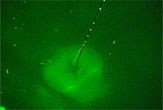LIDAR Laser Radar Finding More Uses

BALTIMORE (AP) -- If you've ever been pulled over for speeding, you may already know something about LIDAR. A laser-based radar system, LIDAR can tell if you're speeding by bouncing a light beam off your car and seeing how quickly it returns. From an airplane or a satellite, LIDAR can calculate the distance to the ground, and by repeating the process millions of times as it flies over, map the lay of the land.
LIDAR also has been used to tell the speed of the wind by bouncing laser beams off dust particles pushed by the wind, and to measure pollution by how the light is changed when it shines through various molecules.
LIDAR is finding more and more uses as the cost of the device drops and increasingly powerful computers are able to more easily handle the massive amounts of data produced by the scans.
LIDAR is primarily being used to quickly map an area, said Chris Parker, the founder of Applied Imagery, a Silver Spring company which has developed software to allow desktop computers to more easily handle the data.
"LIDAR is the fastest way to map new terrain, that's why LIDAR is about to take off," Parker said.
Unlike plain paper maps, however, three-dimensional maps can be made, allowing users to zoom in and view the terrain from any vantage point, giving the impression of what it would be like to walk down the street, or fly overhead.
To help unlock the power of the data, two researchers at Johns Hopkins Applied Physics Laboratory developed the Applied Imagery software by working around the capabilities of commercially available computer graphics cards. The software can create animations that play on modern home computers, overlaying maps and changing the lighting to reflect various times of day and seasons, Parker said.
Sign up for the Live Science daily newsletter now
Get the world’s most fascinating discoveries delivered straight to your inbox.
That ability has already worked LIDAR into Hollywood, where it was used to help create scenes of New York and Los Angeles for the film "Day After Tomorrow,'' a thriller about the catastrophic effects of global warming, he said.
LIDAR scans are done mostly from the air, by satellite in some cases, and also by plane or helicopter. The U.S. Geological Survey has flown over Mount St. Helens to see how volcanic activity has changed the shape of the mountain and used low-altitude helicopter scans to examine earthquake fault lines.
The scans, which commonly measure points a yard apart, are accurate in measuring elevation to within four inches, marked the first time NASA and USGS joined forces to use the technology to measure volcanic change to a mountain, the two agencies announced.
While GPS, or Global Positioning System, devices can provide accurate location data, the sensors have to be located on site. The LIDAR scans can provide information that is not found in any other data set, said David Harding, a scientist at NASA's Goddard Space Flight Center, Greenbelt, Md.
LIDAR is also being used on coastal areas to monitor beach erosion, plan the route of power lines and even monitor the condition of electrical transmission lines. On the ground, it has been used in agriculture to monitor levels of dust, water vapor, ammonia, and other emissions from farm operations.
Mary Hyatt, of Frederick-based EarthData, said LIDAR is becoming increasingly popular for flood-plain mapping because planes can obtain images day or night, but it is even used in anti-terrorism work. Lines of sight that could be used by a sniper, for example, can be determine by looking at rooftop elevations.
Forestry companies are also using the technology, scanning the tree tops to see how thick the forest has grown, said Kenneth W. Hudnut, head of the Southern California Earthquake Hazards Assessment Project for the U. S. Geological Survey.
"There's no way you could have done these things five years ago, let along 10 years ago," said Hudnut, who said he uses the Applied Imagery software to view LIDAR scans of earthquake faults.
He predicted uses will continue to increase as computer technology improves. Damage assessment of areas struck by earthquakes, hurricanes or other natural disasters are one area where LIDAR and other aerial imaging techniques will be increasingly used, Hudnut said.
As computers continue to improve, Hudnut said he expects an airplane, for example, could fly over a city, scanning the terrain in detail. Three-dimension images could then be created almost in real-time and compared with pre-disaster images, showing which buildings have collapsed, and even which might be in danger of collapsing.
"You can look, for example, for deviations from a rectangular shape. If from your pre-earthquake image you know this building's footprint is exactly rectangular, and the building didn't collapse, but maybe it's been distorted," Hudnut said.
"The hope is to get accurate maps of damage and get that in into the hands of emergency responders hoping to be able to help save lives in future disasters. Not only in earthquakes, but other types of disasters, hurricanes, floods, monsoons. There are a whole variety of things where these methods could come into play."









